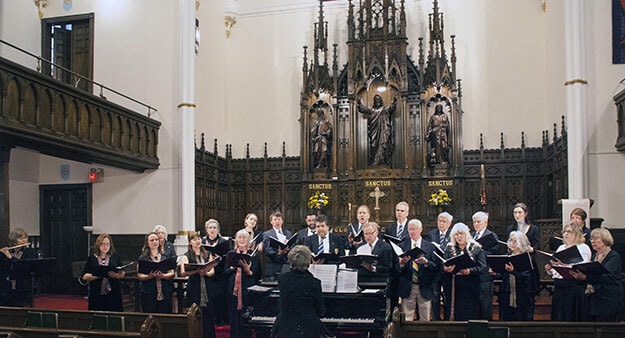 New Yorgi Eesti Segakoori Kontsert pühapäeval 1. mail 2016 New Yorgi Eesti Ev. Luteri Usu Kirikus. Foto: Al Brownell
New Yorgi Eesti Segakoori Kontsert pühapäeval 1. mail 2016 New Yorgi Eesti Ev. Luteri Usu Kirikus. Foto: Al Brownell
May 1st Concert
The Immanuel Lutheran Church on Lexington Avenue and 88th Street hosted a choral concert by the New York Estonian Mixed Choir in a program featuring both classical, but mostly Estonian music. Prominently featured were a father and daughter: Rudolf Tobias, the “father of Estonian music” and Helen Tobias-Duesberg, a respected and well-regarded composer in America and Europe. When Estonians are asked, “What is the most important export from your country?”, the uniform answer is always, “Music!”.
Choral singing is such an enormous part of Estonian culture that the country comes together every four years for the pleasure of singing together. This, however, is no homey affair with guitars and harmonicas. Choirs all over the country and, for that matter, all over the world practice during those years for the unique purpose of gathering on stage to sing. There can be as many as 25-30,000 singers on stage, with half the population of Estonia in the audience. Small wonder then that the film, “The Singing Revolution” emanated from this small country that so values singing, and choral singing, in particular.
It is with this background information that I ventured to Immanuel Lutheran Church on May 1st. I had been somewhat prepared for the avocational nature of the choir by the conductor, Maaja Roos, whom I had the honor of calling my teacher in previous choral experiences. Indeed, she is the reason I have become a musician, and it was thrilling to realize Eks Teie Tea, (Know Ye Not) was on the program. Since Ms. Roos shared that this was a volunteer choir of different ages from the community, and that it was an act of love and commitment that brought these singers together, I quietly anticipated it might be a concert to leave critical ears at the door and just appreciate the intentions of devoted music lovers.
How little was I prepared then, to not only thoroughly enjoy the concert, but to be jolted to my musician’s critique ears and, finally, to be surprised by the emotion and intensity that grabbed me by the throat and brought me on the verge of tears. This small choir was able to accomplish what few professional choirs can lay claim to, — not just to sing with precision and technical expertise, but to make music truly come alive. It is this kind of singing from the heart that is so unusual and, ultimately, so gratifying. At its best one forgets what voices or instruments are playing. One only revels in the music.
It is small wonder then that this little country of Estonia has produced such world class music, perhaps most famously through the contemporary composer Arvo Pärt, reputedly the most published and performed composer in the world today. But Rudolf Tobias, not known so well on an international scale but who rightly deserves to hold a place among the greatest master composers, along with Bach and Beethoven. I had read about his phenomenal oratorio, Jonah’s Mission, that one prominent critic considered to be on a scale of the St. Matthew Passion. I listened to it with jaw-dropping awe and was amazed to see an excerpt on the program, the duet, Oh Mis on Inimlaps? (What Is Man That Thou Art Mindful of Him?) sung by Grace Eckmann, soprano, and Leila Roos, alto. This was as close as you could get to a professional performance, both vocally and interpretively. Rudolf Tobias begins with a single c sharp minor chord for the alto entrance, asking why God would hold Man in such regard. Ms. Roos intoned with a dark mysticism and rich alto tone that spiraled into gorgeous harmony with the entry of Ms. Eckmann’s angelic voice. With the soprano solo in the middle, it became clear that this young singer is headed for a career.
Other noteworthy pieces included a rousing rendition of Haydn’s, The Heavens Are Telling and a lovely arrangement of, My God and I. But what deserves particular mention is Helen Tobias-Duesberg’s Sermon on the Mount and Ye Are the Light of the World. This is music that should be known and heard on a wide spectrum. The teachings of Jesus and the message of humility are musically depicted in each blessing, and the word painting is so clear it could be sung in any language and thoroughly understood just through the music. The flutist, Leelo Valdsaar (Naples Philharmonic), was a superb collaborator to the choir, leading and inspiring each entrance and echoing each nuance with the voices. Together they did justice to each of the teachings, including blessings for the poor in spirit, the meek, they that hunger after righteousness. As I was listening to the Sermon on the Mount I thought of this little country of Estonia having been swallowed up by so many bigger countries throughout history. Yet singing and Song have preserved its national identity more than swords and armies ever could. God bless Estonia and “The Little Engine That Could”, represented by this courageous and inspired Estonian Mixed Choir!
Haldun Rochester













